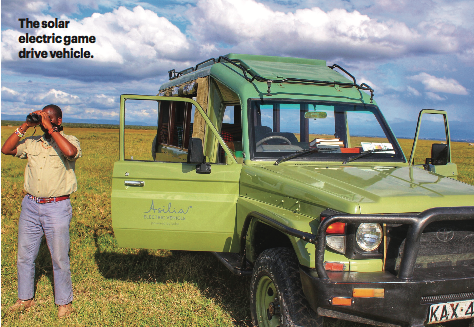Sustainable travel: Eco-friendliness is the new luxury in the tourism industry

“Buckle your seatbelt. This will be an experience you will live to remember,” says Dume Oletilla, my tour guide from Ol Pejeta Bush Camp. And indeed it was, in the 4 by 4 electric car.
I am no vehicle expert, but I know an industry changer when I see one. We drove around Ol Pejeta Conservancy checking out the animals, Dume sharing interesting facts about them.
I love game drives because you get to learn so much on flora and fauna in the wild. In addition, it helps release tension and relaxes the mind.
The electric car was my focus in this game drive and trying to find out just how different it is from the fuel one.
Learning that the vehicle works with a powered battery, I at first had reservations about it. The battery usage displays on the dashboard as you move along, and I couldn’t help but wonder, what if the battery dies and we’re left stuck in the middle of nowhere with wild animals?
Dume laughed at my hesitation, assuring me that that would not happen, and encouraged me to join him in the adventure.

It had rained heavily the week prior, hence the track was all muddy as the guide rode around at a speed if 40 km/h. Being an experienced off-road driver, he explains how easy it is to use this car compared to the previous one.
More than a hundred years ago, the world saw a rise in popularity of electric cars. It was a series of breakthroughs starting with motors powered by non-rechargeable batteries to rechargeable ones, which eventually resulted in the first properly functioning car on the road.
They were loved for the quiet, easy to drive, and pollution-free nature. Then there was a silent period in as far as introduction of alternative fuel cars to the market is concerned, but behind the scenes, scientists and engineers went on researching on how to improve the electric vehicle technology.
Currently, more and more camps are using electric powered vehicles as they look to be more eco-friendly.
Ol Pejeta Bush Camp saw the arrival of their first electric solar-powered safari 4 by 4 in October 2019. Their desire was not only to improve the game drive experience for the traveller, but also to minimize their carbon footprint.
Since their camps too are powered by solar, they felt that it would be a great idea to have vehicles run by the same. 
Dume adds that the lifespan of this vehicle is also more than that of a fuel-powered one. I was surprised to find out that the battery I feared would die mid-safari has the capacity to last more than 200,000km.
All-electric cars are also more efficient; the batteries convert 59 to 62 per cent of energy into vehicle movement, while fuel-powered ones only convert between 17 and 21 per cent.
When it comes running cost, electric cars are less expensive due to the lower cost of maintenance, and the camp would rather not deal with petrol station runs every now and then.
Again, they are lighter and quieter, and this meant that we could clearly hear bush sounds like those of birds calling or zebras braying during the adventure.
This compared to my morning game drive on a diesel vehicle was much more enjoyable. What’s more, the herds of elephants, impalas, warthogs as well as buffaloes were not moved by our presence even as we approached them. 
They continued, unfazed by our arrival, actually seeming relaxed by the fact that we were watching them do their usual thing. It is at this moment that we saw a kori bustard, one of the heaviest birds in the world, walking stealthily past us.
“This one is a male, by the way it’s inflated its neck and trailed its wings in an effort to attract a female,” the guide explains. It was a sight to behold, and I could only think of how amazing nature is.
We passed by the rhino cemetery, a reminder of how poaching depletes the precious ungulates’ population, and the devastation of illegal wildlife trade. Morani, who has posthumously become the ambassador of the conservancy, was the first rhino to be buried in the cemetery.
An information centre on the rhinos was set up because of him. I took a closer look at Sudan’s tombstone, the last male northern white rhino, whose death in 2018 made headlines across the world.
Watching the film Kifaru and how challenging the safeguarding the species is made me emotional.
As we wrapped up the day, it was scenic to have a sundowner with the backdrop of wildlife. More importantly, I felt fulfilled to have taken a game drive for once that was environmentally conscious.
The camp organises game drives in the morning, afternoon and evenings, and once I was back at my tent, I couldn’t stop thinking about how my next one in that game-changing car would be.



